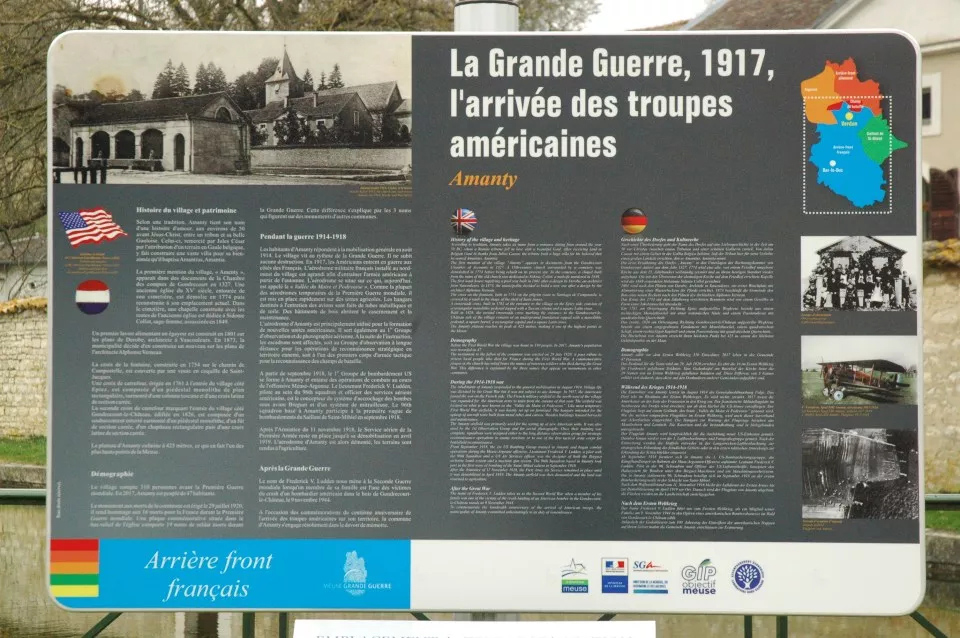Amanty American Airfield WW1 Info Panel
Details:
At the corner of Grand Rue (D32) and rue Sidonie Collot, the 2 signs are in front of the washhouse.
A large rounded-rectangle metal panel containing featuring various images and history about the village, the former airfield, and the arrival of the Americans during World War I. The inscriptions are written in three languages; French, English, and German.
Source of photos: Jean-Loup Frommer / www.aerosteles.net
Monument Text:
La grande Guerre 1917
l'arrivée des
Américains
Amanty
En 1917 les Américains entrent en guerre aux côtés des Français.
L'aérodrome français installé au nord-ouest du village est agrandi afin d'entraîner l'armée américaine à partir de l'automne. L'aérodrome se situe sur ce qui, aujourd'hui s'appelle la "Vallée du Maire et Podevosse". Comme la plupart des aérodromes temporaires de la Première Guerre mondiale, il est mis en place rapidement sur des terres agricoles. Les hangars destinés à l'entretien des avions sont faits de tubes métalliques et de toile. Des bâtiments de bois abritent le casernement et la maintenance.
L'aérodrome d'Amanty est principalement utilisé pour la formation de nouvelles unités américaines. Il sert également au 1ier Groupe d'observation et de photographie aérienne. A la suite de l'instruction, les escadrons sont affectés, soit au Groupe d'observation à longue distance pour les opérations de reconnaissance stratégique en territoire ennenmi, soit à l'un des premiers corps d'armée tactique pour la reconnaissance des champs de bataille.
A partir de septembre 1918, le 1ier Groupe de bombardement US se forme à Amanty et entame des opérations de combats au cours de l'offensive Meuse-Argonne. Le Lieutenant Frederick V. Ludden, pilote au sein du 96th. squadron, et officier des services aériens américains, est le concepteur du système d'accrochage des bombes sous avion Breguet et d'un système de mitrailleuse. Le 96th. squadron basé à Amanty participe à la première vague de bombardements du Saillant de Saint-Mihiel en septembre 1918.
Après l'Armistice du 11 novembre 1918, le Service aérien de la Première Armée reste en place jusqu'à sa démobilisation en avril 1919. L'aérodrome d'Amanty est alors démonté, les terrains sont rendus à l'agriculture.
Le nom de Frederick V. Ludden nous mène à la Seconde guerre mondiale, lorsqu'un membre de sa famille est l'une des victimes du crash d'un bombardier américain dans le bois de Gondrecourt-le-Château, le 6 novembre 1944.
English translation:
*This is just the translated version of the above text, not the actual English inscription on the panel.
The Great War 1917
The arrival of the
Americans
Amanty
In 1917 the Americans went to war on the side of the French.
The French aerodrome installed northwest of the village was enlarged in order to train the American army from the fall. The aerodrome is located on what today is called the "Vallée du Maire et Podevosse". Like most temporary World War I airfields, it was set up quickly on farmland. Aircraft maintenance hangars are made of metal tubing and canvas. Wooden buildings house the barracks and maintenance.
The Amanty airfield is mainly used for the training of new American units. It also served with the 1st Aerial Photography and Observation Group. Following the training, the squadrons are assigned either to the Long Range Observation Group for strategic reconnaissance operations in enemy territory or to one of the first tactical army corps for the reconnaissance of military fields. battle.
In September 1918, the 1st U. S. Bombardment Group was formed at Amanty and began combat operations during the Meuse-Argonne offensive. Lieutenant Frederick V. Ludden, a pilot with the 96th Squadron, and officer of the American Air Services, is the designer of the system for attaching bombs under Breguet aircraft and of a machine gun system. The 96th Squadron based in Amanty took part in the first wave of bombardments of the Saillant de Saint-Mihiel in September 1918.
After the Armistice of November 11, 1918, the Air Service of the First Army remained in place until its demobilization in April 1919. The Amanty airfield is then dismantled, and the land is returned to agriculture.
The name of Frederick V. Ludden leads us to World War II, when a member of his family was one of the victims of the crash of an American bomber in the wood of Gondrecourt-le-Château, on November 6, 1944.
Commemorates:
People:
Units:
1st Bombardment Group
96th Aero Squadron
US Army Air Corps
Wars:
WWI

